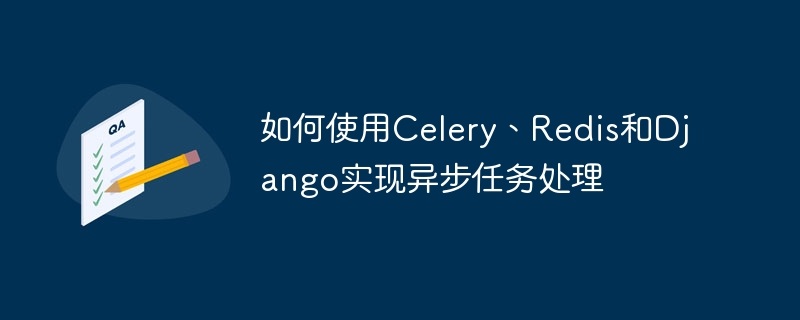

How to use Celery, Redis and Django to implement asynchronous task processing
Introduction:
When developing web applications, we often encounter things that require a lot of time time to perform tasks, such as sending emails, generating PDF files, etc. If these tasks are executed in the main thread, the user will have to wait for the task execution to be completed before receiving a response, affecting the user experience. In order to improve performance, we can use asynchronous task processing to execute these time-consuming tasks in the background so that users can get responses quickly. This article will introduce how to use Celery, Redis and Django to implement asynchronous task processing, and give detailed code examples.
1. What is Celery, Redis and Django
2. Install and configure Celery, Redis and Django
Install Celery and Redis:
pip install celery pip install redis
Configuration Celery:
Add the following configuration in the settings.py file of the Django project:
# Celery配置 CELERY_BROKER_URL = 'redis://localhost:6379/0' CELERY_RESULT_BACKEND = 'redis://localhost:6379/0' CELERY_ACCEPT_CONTENT = ['json'] CELERY_RESULT_SERIALIZER = 'json' CELERY_TASK_SERIALIZER = 'json' CELERY_TIMEZONE = 'Asia/Shanghai'
It is assumed that Redis is running locally and the port is 6379.
Create a Django application and asynchronous task:
Create an application in the Django project and define an asynchronous task.
# 创建Django应用 python manage.py startapp myapp # 在myapp/tasks.py中定义异步任务 from celery import shared_task @shared_task def send_email_task(email): # 发送邮件的逻辑
4. Write Django views and test asynchronous tasks
Write Django views:
Write a view function in the views.py file of the Django application, use For receiving user requests and calling asynchronous tasks.
from django.shortcuts import render
from myapp.tasks import send_email_task
def send_email(request):
# 获取用户请求参数
email = request.GET.get('email')
# 调用异步任务
send_email_task.delay(email)
return render(request, 'send_email.html')Start Celery worker:
Execute the following command in the command line to start Celery worker:
celery -A your_django_project_name worker --loglevel=info
Test asynchronous tasks:
Start Django Develop the server, access the URL for sending emails, and pass the email parameters. Celery will put the task into the message queue and execute it in the background.
http://localhost:8000/send_email?email=test@example.com
Summary:
Using Celery, Redis and Django can easily implement asynchronous task processing. By executing time-consuming tasks in the background, the performance and user experience of web applications can be greatly improved. In actual development, tasks can also be optimized and expanded according to specific needs, such as setting the priority and timeout of tasks, handling task execution failures, etc. I hope this article can help you understand and use Celery, Redis and Django to implement asynchronous task processing.
The above is the detailed content of How to implement asynchronous task processing using Celery, Redis and Django. For more information, please follow other related articles on the PHP Chinese website!
 Commonly used database software
Commonly used database software
 What are the in-memory databases?
What are the in-memory databases?
 Which one has faster reading speed, mongodb or redis?
Which one has faster reading speed, mongodb or redis?
 How to use redis as a cache server
How to use redis as a cache server
 How redis solves data consistency
How redis solves data consistency
 How do mysql and redis ensure double-write consistency?
How do mysql and redis ensure double-write consistency?
 What data does redis cache generally store?
What data does redis cache generally store?
 What are the 8 data types of redis
What are the 8 data types of redis




